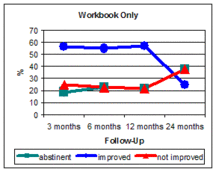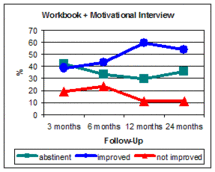Few of the millions of people who encounter problems with addiction ever seek treatment. People with gambling problems, for which treatment is less available and less publicized than other addictive behaviors, are likely no exception.1 Research suggests that many disordered gamblers do not seek treatment because they want to handle the problem on their own (Hodgins & el-Guebaly, 2000). For these people brief treatments and self-help tools are important treatment options and their efficacy should be a major topic for the field of gambling studies. Hodgins, Currie, and el-Guebaly (2001), in a study reviewed by WAGER 7(3), tested the efficacy of a self-help workbook and the workbook supplemented with a brief motivational interview. Participants in both intervention groups reported significant decreases in their gambling behaviors. At the 12-month follow-up interview, improvement was not significantly different between intervention groups. Because treatment outcome studies typically do not go beyond a 12-month follow-up, we know less about more long-term treatment outcomes. This week’s WAGER reviews a report by Hodgins, Currie, el-Guebaly, and Peden (2004) on the 24-month outcomes of their intervention study.
Through advertisements, Hodgins and his colleagues recruited 102 participants with concerns about their gambling. They assigned participants to one of three groups: waitlist (n = 33), self-help workbook (n = 35), or workbook and 30-minute motivational interview (n = 32). The waitlist condition was only retained for one month and information from these participants is not included in the analyses. The workbook included sections on self-assessment, goal setting, strategies, maintenance, and resources. The telephone motivational interview was conducted by a clinical psychologist and addressed participant concerns, ambivalence, self-efficacy, and specific sections of the workbook that might be helpful for the individual. Both interventions are described in detail in WAGER 7(3).
At the 24-month follow-up, Hodgins et al. (2004) interviewed 78% of the original 67 intervention participants. Those who participated at 24-months were significantly more likely to have been employed fulltime at enrollment than those who did not participate; the groups did not differ significantly on any other demographic variable (e.g., age, gender, gambling type). The follow-up interviews were conducted by phone and included questions about days gambled and money lost (using a timeline follow-back technique, see Sobell & Sobell, 1996), and the South Oaks Gambling Screen (SOGS, Lesieur & Blume, 1987).
To examine the intervention trajectories, Hodgins et al. (2001, 2004) used reported past month gambling behavior to categorize gamblers at each time point into abstainers, improvers (dollars lost per month since last assessment equal to 50% or less of dollars lost per month pretreatment), and non-improvers. The proportions in each category for the two intervention groups at 3, 6, 12, and 24 months are presented in Figure 1 and the significance of the differences at each time point are described below.2 Hodgins et al. (2004) also compared the groups’ 24-month follow-up SOGS scores using an analysis of covariance.
Figure 1. Outcome Trajectories for Workbook and Motivational Interview Interventions (adapted from Hodgins et al., 2001, 2004).
At 24 months, respondent classification differed significantly between the two intervention groups, c2(2, N = 52) = 6.6, p < .05. Both intervention groups had similar abstinence rates of more than 30%. However, among non-abstinent respondents, participants and the motivational interview condition were more likely to be improved than not improved (54% vs. 11%), whereas participants in the workbook-only condition were less likely to be improved than not improved (25% vs. 38%). As the Figure shows, the workbook-only group maintained fairly stable proportions of abstinent, improved, and not improved respondents during the first 12 months. During the more infrequently studied second year after treatment, the workbook-only participants showed a decrease in the proportion falling into the improved category, matched by an increase in both the proportion who abstained from gambling and the proportion who gambled at pretreatment levels. The group receiving a motivational interview evidenced decreasing proportions of non-improved participants, increasing proportions of improved participants, and a slight decrease in abstinence across the two years.
SOGS scores for both groups were much lower at 24 months (workbook-only M = 6.6, SD = 5.5; motivational interview M = 4.3, SD = 3.5) than pre-treatment (overall M = 12, SD = 3.6). Analysis of covariance revealed that, controlling for pre-treatment scores, the motivational interview group’s 24-month SOGS score was significantly lower than that of the workbook-only group (F(1,48) = 4.2, < .05).
This study showed that people with gambling problems assigned to a workbook and motivational interviewing intervention reported slightly better outcomes at a 24month follow-up than those given only the workbook. More generally, this extension of Hodgins and colleagues’ earlier study (see WAGER 7(3)), showed that positive treatment effects remained two years after initial treatment but that those effects were volatile (i.e., individuals shifted categories in both improved and relapsing directions across time). Limitations to the study include the small sample size, the lack of a control condition for the follow-ups, and the use of self-report. It is possible that participants in the motivational interview condition, who had previous telephone contact with an interviewer interested in their improvement, were more inclined to report favorable outcomes than the workbook group.
The limitations of the study urge caution in interpreting its results, but the length of the follow-up adds strength to the findings. The large proportions of improved and abstinent participants across 2 years indicates that brief interventions and self-help tools are promising, economical strategies for reaching out to disordered gamblers who might not seek or accept clinical treatment.3 Future research using additional measures (other than telephone self-report), is needed to test whether motivational interviewing itself (i.e., without a workbook) is a better intervention than self-help workbooks.
Comments on this article can be addressed to Sarah Nelson.
Notes
1 To date, no research has identified the proportion of disordered gamblers who seek treatment.
2 Results for months 3, 6, and 12 are summarized from Hodgins et al., 2001.
3 In fact, average SOGS score improvements reported by Stinchfield and Winters (2001) in a one-year follow-up of enrollees to state gambling treatment programs were similar to those found in this study, further supporting the economical promise of brief interventions.
References
Hodgins, D. C., Currie, S. R., & el-Guebaly, N. (2001). Motivational enhancement and self-help treatments for problem gambling. Journal of Consulting and Clinical Psychology, 69(1), 50-57.
Hodgins, D. C., Currie, S. R., el-Guebaly, N., & Peden, N. (2004). Brief motivational treatment for problem gambling: A 24-month follow-up. Psychology of Addictive Behaviors, 18(3), 293-296.
Hodgins, D. C., & el-Guebaly, N. (2000). Natural and treatment-assisted recovery from gambling problems: A comparison of resolved and active gamblers. Addiction, 95(5), 777-789.
Lesieur, H. R., & Blume, S. B. (1987). The South Oaks Gambling Screen (SOGS): A new instrument for the identification of pathological gamblers. American Journal of Psychiatry, 144(9), 1184-1188.
Sobell, L. C., & Sobell, M. B. (1996). Timeline Follow-Back user’s guide: A calendar method assessing alcohol and drug abuse. Toronto, Ontario, Canada: Addiction Research Foundation.
Stinchfield, R., & Winters, K. C. (2001). Outcome of Minnesota’s gambling treatment programs. Journal of Gambling Studies, 17(3), 217-245.






